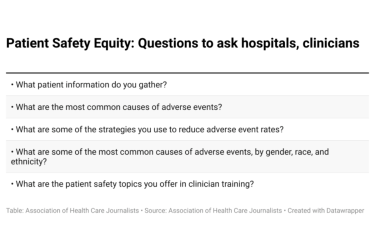
Higher levels of registered nurse staffing are associated with a lower likelihood of Medicare patients’ dying from sepsis in hospitals, according to a recent study published in JAMA Health Forum. An estimated 1.7 million cases of sepsis occur each year, killing 270,000 annually. Even more concerning is one in three patients who die in the hospital has sepsis, according to the CDC. Not all of those deaths occur because of sepsis, but it’s a contributing factor in nearly all cases.
The vast majority of infections that cause sepsis, however — 87% of them — begin outside the hospital, according to the CDC. The difference between life and death depends on early identification of sepsis and immediate treatment. Registered nurses play a significant role in that process because they have more regular interaction with patients and more opportunities to observe symptoms of sepsis.
Why does this study matter to journalists?: Nurses continue to be an under-appreciated and under-utilized resource for better understanding health care issues. Here are some key takeaways from this study:
- Nurses can play a crucial role in the prevention and treatment of a wide range of conditions.
- Journalists need to include nurses in their source lists when reporting on diseases, hospital-acquired infections, and other conditions that have traditionally involved only quoting physicians.
- Sepsis continues to be an under-covered condition that journalists may want to explore, especially in an era when COVID-19 and monkeypox continue to drain hospital resources and may affect how quickly health care workers recognize time-sensitive conditions like sepsis.
- Story ideas for journalists might include finding out what nurse initiatives are occurring in local hospitals to address quality improvement issues that nurses are more suited to identifying and addressing than physicians or administrators.
- Story idea: What are the nurse staffing ratios at your local hospitals? How do these ratios compare to what research has found is most appropriate for preventing types of in-hospital deaths?
- Story idea: What are your local hospital’s Severe Sepsis and Septic Shock Management Bundle (SEP-1) compliance scores? What are they doing to improve them?
In the recent study, researchers led by Jeannie P. Cimiotti, Ph.D., from the Nell Hodgson Woodruff School of Nursing at Emory University in Atlanta, analyzed data from three sources:
- The 2018 American Hospital Association (AHA) Annual Survey on hospital size, teaching and technology status, and nurse staffing
- 2018 patient characteristics from the Medicare Provider Analysis and Review (MedPAR) file on all Medicare fee-for-service acute care hospitalizations
- 2018 hospital performance on the Severe Sepsis and SEP-1 bundle for timely and effective sepsis care from the CMS Hospital Compare
SEP-1 represents how many patients received appropriate care for severe sepsis or septic shock. The analysis included 1,958 general acute care hospitals across the U.S. but did not include federal hospitals or those that did not report data on SEP-1 scores or nursing staff. The 702,140 patients studied were Medicare beneficiaries aged 65-99 who were admitted with a primary diagnosis of sepsis. Nearly half (46%) were admitted to an ICU; 12% received palliative care.
Unsurprisingly, higher SEP-1 scores were linked to lower death rates. Every 10% increase in SEP-1 score was associated with a 2% lower risk of death within 60 days of admission after making adjustments to a count for characteristics of both the patient and the hospital.
Higher levels of RN staffing were also linked to a better chance of survival. Each additional hour of RN staffing per day of a single patient’s stay was linked to a 3% lower risk of death within two months of admission. Death within 60 days was 16% lower if an intensivist was on staff after taking into account differences in the hospitals and patients.
The researchers found that “if all hospitals were staffed at six registered nurse hours per patient day or higher, there could be 1,266 fewer deaths.” If all hospitals were staffed at nine registered nurse hours per patient day or higher, they wrote, “there could be 6,360 avoided patient deaths.”
Overall, researchers noted that SEP-1 compliance scores were low across the board in the nation, with many patients continuing to die despite advances in identifying and treating sepsis.
“Based on our analysis of hospitals and patients nationwide, the study findings suggest that nurse workload is an overlooked and underused aspect of the treatment bundle for patients with a diagnosis of sepsis,” the authors wrote. “Recognizing sepsis early is essential, and the effect of interprofessional teamwork cannot be overlooked. It has been reported that nurse-physician communication and collaboration are necessary components to improve sepsis care.”
Rapid identification of sepsis frequently relies on nurses’ initiating sepsis protocols, yet 58% of physician directors and 48% of nurse managers have cited nurse staffing as the main cause of delays in treating sepsis, the authors wrote.
The authors had previously published an article noted that ”each additional patient added to a nurse’s workload was associated with a 12% increase in the likelihood of in-hospital death, a 7% increase in 60-day mortality and 60-day readmission, and longer lengths of stay in patients with sepsis.” In evaluating ways to reduce patient’s risk of sepsis, severe sepsis, and death from sepsis, “it is imperative that we include the workload of nurses and other clinicians and promote a caring environment that fosters interprofessional communication,” the authors concluded.










